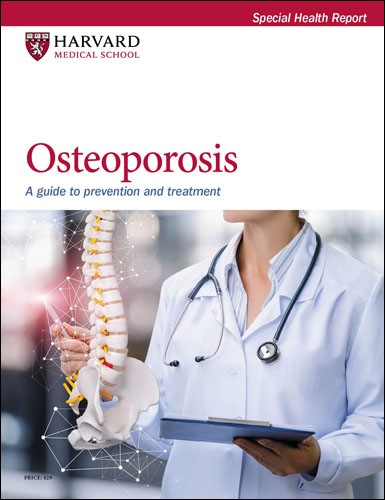
5 timeless habits for better health

What are the symptoms of prostate cancer?

Is your breakfast cereal healthy?

When pain signals an emergency: Symptoms you should never ignore

Does exercise give you energy?

Acupuncture for pain relief: How it works and what to expect

How to avoid jet lag: Tips for staying alert when you travel

Biofeedback therapy: How it works and how it can help relieve pain

Best vitamins and minerals for energy

Should you take probiotics with antibiotics?


A Guide to Women's Health: Fifty and forward
Midlife can be a woman’s halftime celebration. Not only can it be an opportunity to reflect on and rejoice in the life you’ve lived, but it is also a good time to plan your strategy for the future. A Guide to Women's Health: Fifty and forward will help you determine the conditions for which you are at greatest risk and do your best to avoid them. It will also help you to better manage chronic conditions that may erode your quality of life, and to deal with physical changes that are more bothersome than serious. It is designed to give you the information to make the choices today that will ensure you the best health possible tomorrow.
Other Product Information
Midlife can be a woman’s halftime celebration. Not only can it be an opportunity to reflect on and rejoice in the life you’ve lived, but it is also a good time to plan your strategy for the future. It’s impossible to envision the second half of life without thinking about your health, especially your risk of developing debilitating or life-threatening diseases in the future. Around age 50, the medical decisions are changing and coming more frequently — when to have a mammogram, colonoscopy, or bone density test, for example. You may be trying to decide whether to have bunion surgery, or a knee replacement. Or you may be puzzling over the best way to manage your arthritis or irritable bowel syndrome.
Women’s health studies have shown not only that women are different from men physiologically and emotionally, but also that it’s never too late to feel better by living better. This report focuses on health, not disease. It won’t tell you how to get the best treatments for serious conditions. But it will help you determine the conditions for which you are at greatest risk and do your best to avoid them. It will also help you to better manage chronic conditions that may erode your quality of life, and to deal with physical changes that are more bothersome than serious. It is designed to give you the information to make the choices today that will ensure you the best health possible tomorrow.
Prepared by the editors of Harvard Health Publishing in consultation with Toni Golen, MD Associate Professor of Obstetrics, Gynecology, and Reproductive Biology, Harvard Medical School. 53 pages (2024).
If you are in midlife or later, you’ve probably already experienced some signs of aging: your joints may ache, your skin may feel dry, and you may not sleep as well as you used to. Midlife is also a time when the risk of degenerative disease starts to climb. Many of the chronic conditions that begin to plague women in midlife are due, in part, to declining levels of estrogen, which helps to maintain tissues in the body’s reproductive organs, and also in the breasts, brain, bones, bladder, and cardiovascular system. Genetic makeup is also complicit, as are the cumulative effects of normal aging, environmental forces, and lifestyle choices...
- Taking stock of your health at midlife
- Understanding your health risks
- Cardiovascular disease
- Stroke
- Lung cancer
- Chronic obstructive pulmonary disease (COPD)
- Alzheimer’s disease
- Accidents
- Breast cancer
- Diabetes
- Influenza and pneumonia
- Colorectal cancer
- Ovarian cancer
- SPECIAL BONUS SECTION: 10 steps to a longer and healthier life
- Minimizing potentially disabling disorders
- Osteoporosis
- Osteoarthritis
- Foot problems
- Depression
- Anxiety
- Underactive thyroid
- Pelvic organ prolapse
- Incontinence
- Skin conditions
- Age-related macular degeneration (AMD)
- Coping with chronic conditions
- Fibromyalgia
- Irritable bowel syndrome
- Vaginal pain
- Managing bothersome problems
- Persistent menopausal symptoms
- Dry skin
- Wrinkles
- Rosacea
- Hair loss
- Excessive hair growth
- Resources
- Glossary
You might also be interested in…

Osteoporosis: A guide to prevention and treatment
Each year, osteoporosis contributes to more than 2 million bone fractures in the United States. This Special Health Report, Osteoporosis: A guide to prevention and treatment, can help you keep your bones strong and healthy, and avoid fractures. It describes how you can prevent and treat osteoporosis through diet, exercise, and medications. You'll also find advice on the right amount of calcium and vitamin D, tips on fall-proofing your home, and help with putting together a personalized plan to preserve or boost your bone strength.

5 timeless habits for better health

What are the symptoms of prostate cancer?

Is your breakfast cereal healthy?

When pain signals an emergency: Symptoms you should never ignore

Does exercise give you energy?

Acupuncture for pain relief: How it works and what to expect

How to avoid jet lag: Tips for staying alert when you travel

Biofeedback therapy: How it works and how it can help relieve pain

Best vitamins and minerals for energy

Should you take probiotics with antibiotics?
Free Healthbeat Signup
Get the latest in health news delivered to your inbox!
Sign Up